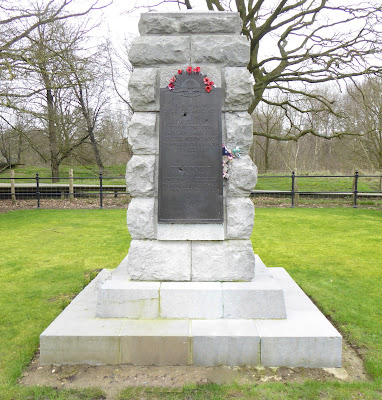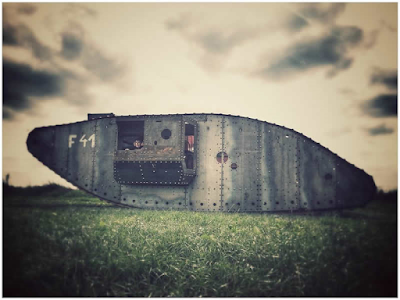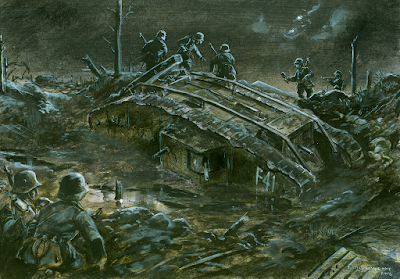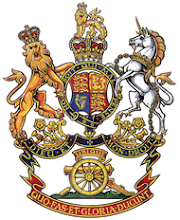Hill 60 situated 5 km south of Ypres was the scene of bitter fighting over the four years of the First World War. The feature changed hands several times during the conflict. The detonation of five mines in 1915 blew the top of the hill, and the explosion of two large mines at the start of the Battle of Messines 1917 added to the topography.
Hill 60 is now a Battlefield Memorial Park containing a number of memorials.
------0------
Hill 60 Battlefield Memorial Park
The Hill 60 Battlefield Memorial Park site is maintained by the Commonwealth War Graves Commission and regarded as a war grave, as remains of those killed during the bitter fighting still lie beneath the land.
It was taken over by the Imperial War Graves Commission in 1930 and the site is maintained in the state in which it was left after World War One.
A memorial stone records the history of the Hill 60 from 1914 to 1918.
 |
| Hill 60 Memorial Park |
A memorial stone records the history of the Hill 60 from 1914 to 1918.
 |
Hill 60 Memorial Park Commemoration Stone |
 |
| Hill 60 Memorial Park Commemoration Stone |
HILL 60, THE SCENE OF BITTER FIGHTING, WAS HELD BY GERMAN TROOPS FROM THE 16TH DECEMBER 1914 TO THE 17TH APRIL 1915, WHEN IT WAS CAPTURED (AFTER THE EXPLOSION OF FIVE MINES) BY THE BRITISH 5TH DIVISION. ON THE FOLLOWING 5TH MAY IT WAS RECAPTURED BY THE GERMAN XV CORPS. IT REMAINED IN GERMAN HANDS UNTIL THE BATTLE OF MESSINES (7TH JUNE 1917) WHEN, AFTER MANY MONTHS OF UNDERGROUND FIGHTING, TWO MINES WERE EXPLODED HERE; AND AT THE END OF APRIL 1918, AFTER THE BATTLES OF THE LYS, IT PASSED INTO GERMAN HANDS AGAIN. IT WAS FINALLY RETAKEN BY BRITISH TROOPS UNDER THE COMMAND OF H. M. KING OF THE BELGIANS ON THE 28TH SEPTEMBER 1918. IN THE BROKEN TUNNELS BENEATH THIS ENCLOSURE MANY BRITISH AND GERMAN DEAD WERE BURIED, AND THE HILL IS THEREFORE PRESERVED, SO FAR AS NATURE WILL PERMIT, IN THE STATE IN WHICH IT WAS LEFT AFTER THE GREAT WAR.
------0------
Queen Victoria's Rifles Memorial
The Queen Victoria's Rifles Memorial commemorates those who lost their lives serving with the Queen Victoria's Rifles (9th Battalion The London Regiment).
 |
| Queen Victoria Rifles Memorial |
The QVR were one of the first Territorial Force battalions to serve in France arriving in Le Havre 5th November 1914. The battalion were on Hill 60 on the 20th April 1915 when the Germans launched a counter attack to try to regain the feature which had been lost to the British five days earlier.
The QVR were involved in a bitter fight which prevented the Germans taking the Hill. When they were relieved on 21st April, only 14 men out of 150 remained. Second Lieutenant Geoffrey Woodely would receive the Victoria Cross for his actions during the engagement.
 |
2.Lieut Geoffrey Woodley VC
Queen Victoria Rifles
|
------0------
1st Australian Tunnelling Company Memorial
The Royal Australian Engineers deployed three mining companies to France in May 1916 formed from men with mining experience. Their role was offensive and defensive mining which included counter mining operations against German miners.
On 7th November 1916, the 1st Australian Tunnelling Company took over tunnels and mines below Hill 60 from the Canadians. Two mines primed with explosives were already in place below the Caterpillar and Hill 60. The Aussies were tasked with maintaining the mines for the forthcoming campaign in Flanders including preventing the Germans destroying them through by counter-mining.
An underground war developed between the Australian and German miners which would result in around 30 Australian casualties. Despite enemy counter mines being blown, the operation was successful and at 03:10 7th June 1917 both British mines were detonated. Two of the nineteen mines which exploded along the Messines Ridge.
Following the Battle of Messines the Austrians continued tunnelling, digging deep dugouts in the Second Army area around Ypres.
A monument was erected in 1919 by the men of the 1st Australian Tunnelling Company to those who lost their lives in the mining and defensive operations of Hill 60. It was replaced in 1923 by the current memorial. During World War Two the monument sustained damage from fighting around Ypres in 1940.
 |
| 1st Australian Tunnelling Company Memorial |
 |
1st Australian Tunnelling Company Memorial
Damage from WW2 visible
|
 |
Officers 1st Australian Tunnelling Company
23rd June 1917
|
------0------
14th (Light) Division Memorial
 |
| 14 Light Division Memorial |
The 14th Light Division was formed in September 1914 from Rifles and Light Infantry battalions of Kitchener's New Army and Regular Army battalions released from overseas garrison duties. It deployed to the Western Front in May 1915 where it's first major was the Action at Hooge, part of the 2nd Battle of Ypres. It was during that action that liquid fire was first used by the Germans. The Division would also be engaged in the Second Battle of Bellewaarde in September 1915.
Originally the memorial was located at Railway Wood in the area of Bellewaarde, north of Hooge. It was moved to Hill 60 in 1978 due to problems with subsidence.
Long Long Trail
The 14 Light Division memorial records the units that served in the Division including the Divisional Artillery.
 |
14 Light Division Memorial
Divisional Artillery
|
The 46th to 49th Brigades Royal Field Artillery together with the Divisional Ammunition column were the original artillery units of the Division. The 46th, 47th and 48th Brigades were equpped with 18 pounder guns, the 49th Brigade with 4.5 inch Howitzers. The 49th (Howitzer) Brigade was broken up in October 1916, the 48th Brigade becoming an Army Brigade in January 1917.





























































